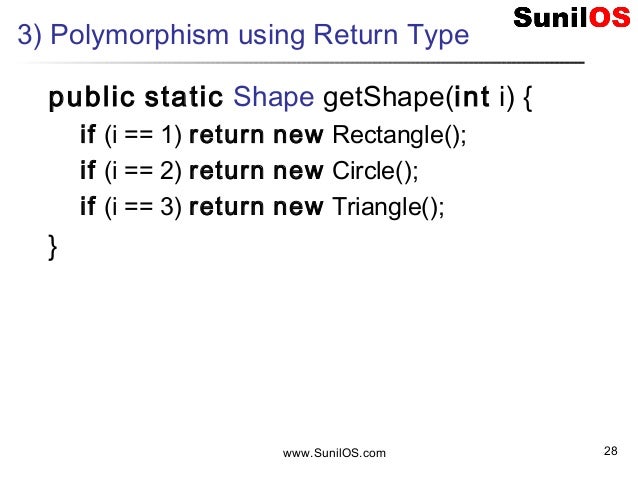

You can find the method overloading in detail here. Static polymorphism in Java can be achieved through Method overloading, Constructor overloading, and Operator overloading. Q5 How you can achieve static polymorphism in Java? Static Polymorphism is a form of polymorphism that decides which method to execute at compile time. Q4 What is static polymorphism (compile time polymorphism) in Java? The child class inherits behavior from the parent class whereas Polymorphism enables the child class to redefine already defined behavior inside the parent class.
#Polymorphism java quiz code#
One of the advantages of Inheritance is code reusability in child class. Inheritance shows the parent-child relationship between two classes whereas Polymorphism takes the advantage of that relationship to make the program more dynamic.Ģ. The major differences between Polymorphism and Inheritance in Java are listed below:ġ. Q3 What is the difference between Polymorphism and Inheritance in Java? Dynamic Polymorphism (Runtime Polymorphism) Static Polymorphism (Compile time Polymorphism)Ģ. There are two types of Polymorphism in Java:ġ. Q2 What are the different types of Polymorphism in Java? Polymorphism Interview Questions and Answers Q1 What is Polymorphism in Java? Read Also: Polymorphism quiz (multiple choice questions and answers) So, please be careful about the format of output files and be sure that they are exactly same with the output files as we have shared.In this post, I will be sharing the most frequently asked polymorphism interview questions and answers in Java for both fresher and experienced professionals. Output files (handball.txt, icehockey.txt) will be evaluated automatically. Compile your code (javac *.java) Run your program (java Main fixtures.txt).Upload your java files to your server account (dev.cs.).In order to test your program, you should follow the following steps:

The input file is going to be given as program argument. Eighth column defines the total number of points earned.Seventh column defines the number of sets For : the number of sets Against.Sixth column defines the number of matches loss.Fifth column defines the number of times a team has finished a match with an even score or tie.Fourth column defines the number of matches won.


 0 kommentar(er)
0 kommentar(er)
